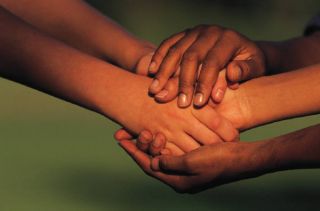Trauma
The Healing Arts After a Crisis: 7 Essential Practices
Just how do we help those who survive mass violence?
Posted July 20, 2012

[Note: I posted this article in response to the Aurora, CO shooting; it unfortunately becomes relevant once again in response to the December 14, 2012 shooting at Sandy Hook Elementary School, Newtown, CT]. This morning several colleagues in Colorado called me to talk about the shooting and the work ahead with survivors and a community once again in shock because of gun violence in the Denver area. One question that always emerges in the wake of a large-scale traumatic event is, “What should we do first?” Practitioners of the “healing arts”—art therapy, music therapy, and other expressive arts therapies—often ask, “How can we use the arts to help survivors cope with tragedy and loss after a horrific, life-changing event?” There are some essential practices, including the healing arts, that helping professionals can apply in the first days and weeks with trauma survivors including those who are exposed to violence.
1) Practice empathy. In the aftermath of a traumatic event, it is much more effective to provide comfort and support than to delve into feelings. Offer simple gestures of assistance (“Can I help you find your family? Or, “May I stay with you in case you need something?), maintain good eye contact, provide undivided attention and attunement, and demonstrate affirmation through nodding and other physical cues. Even if the individual does not seem to be responding to your gestures, your empathy will be perceived by survivors and remembered and appreciated later.
2) Normalize distress. While it is difficult for most survivors to think clearly after an event, clarification, acknowledgment and validation of trauma responses are helpful in normalizing the experience and in slowing down the body’s hyper-drive of somatic reactions. Let survivors know that what they are experiencing is normal and show your appreciation for their courage and stamina.
3) Emphasize the “here-and-now.” Although survivors may feel frightened, angry, or anxious about has happened, reinforce that they are safe right now in this moment. I also ask survivors about what frightens or worries them right now and, if they can, to show me in a simple doodle on paper what that fear or worry looks like in colors, lines or shapes (remember, keep it simple). Once safety has been established, help everyone to stay in the moment and "be here now" to begin the process of reducing recurrent memories of events.
4) Focus on “sensory” safety. Psychological trauma produces a “felt sense” of fear, confusion and worry in most people; it is actually more of somatic sensation than a cognitive experience. In the immediate aftermath of a crisis, comfort food, a cuddly toy or blanket, and even a glass of water will help to slow down the body’s hyper-drive of rapid breathing or heart rate.
5) Pay attention to sensory responses. Remember that survivors are responding from sensory parts of the brain (brain stem and limbic system) rather than executive function (cortex). Mindful breathing, simple relaxation exercises, music at the resting heart rate and prayer (for both spiritual and stress-reducing aspects) are helpful and self-soothing. Ask, “What can you do to give your mind and body a rest right now?” Often, simple activities like physical activity, knitting or crafts, and cooking can help the individual disengage from overwhelming thoughts and body responses; this is particularly important for survivors who display a freeze response and become psychologically numb or dissociative after an event.
6) Introduce self-empowerment. After a crisis, people often want to come together not only to comfort one another, but also to reach out to others. For many people, experiencing a sense of being capable and helpful can start the possibility for posttraumatic growth and resilience-building. While not everyone can be expected to bounce back immediately after an event, experience with disaster relief is demonstrating that these opportunities earlier than later can assist many people in their recovery. This means being trauma-informed (as I have described in previous posts) and reminds us to believe that all individuals can be empowered to participate in their own recovery.
7) Be culturally sensitive, always. Crisis intervention is not a one-size-fits-all operation. It includes identifying and honoring cultural preferences for assistance and any practices that individuals use within their culture to self-soothe, create a sense of safety and reinforce hope in the future. Ask individuals about the “healing arts” in their cultures or communities; you will find a wide range of practices including chanting, prayer, storytelling, music, and ways of making meaning that provide soothing and reparative experiences in times of trauma and loss.
These seven essential practices are just a foundation; for more information on trauma-informed arts-based approaches, visit the Trauma-Informed Practices Institute at www.trauma-informedpractice.com; you can find out more about trauma-informed work at the National Center for Trauma-Informed Care at http://www.samhsa.gov/nctic/.
Cathy Malchiodi, PhD, LPCC, LPAT, ATR-BC
© 2012 Cathy Malchiodi




